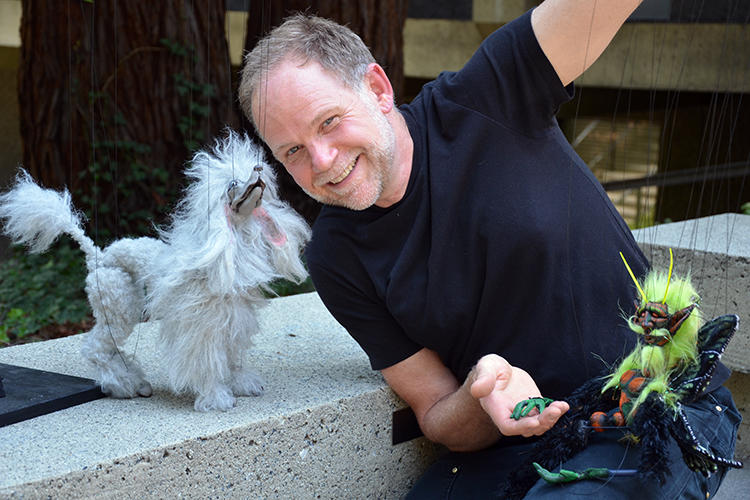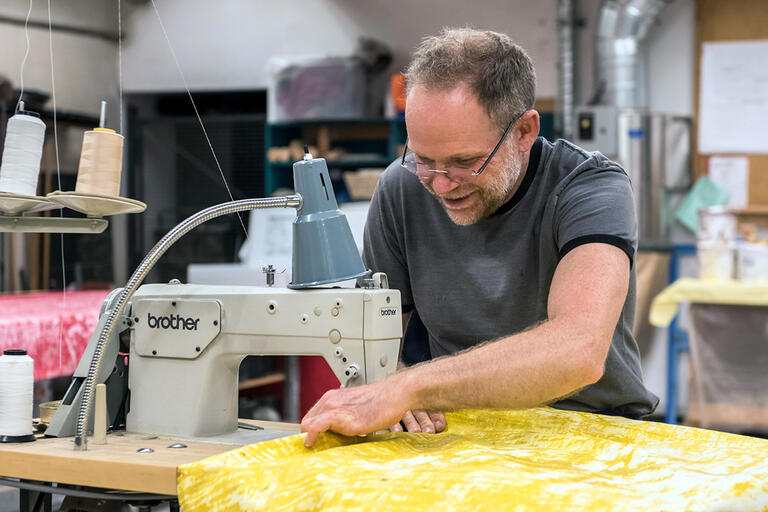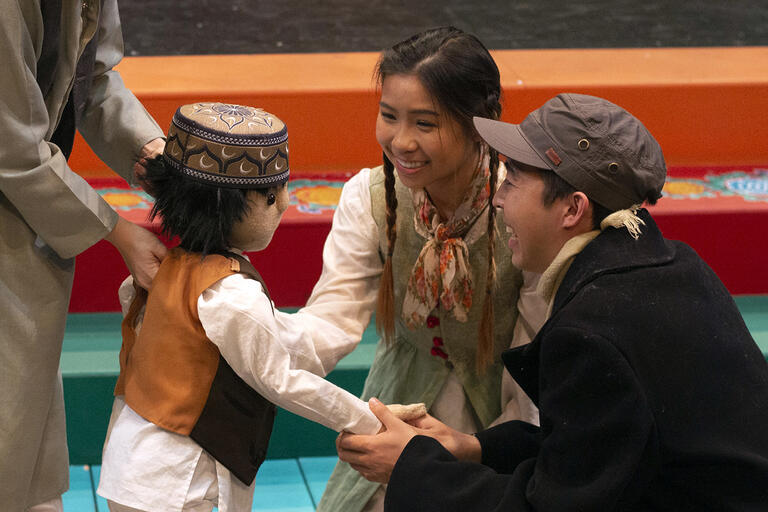After more than 14 years as the staff scenic artist for TDPS, Glynn Bartlett is retiring from UC Berkeley to further pursue his interests in puppetry and other creative projects.
"Although I am retiring from TDPS, I am not retiring from being an artist," Glynn said. "Being an art maker and creator is the most powerful gift you can give yourself and the world. I suspect that the most interesting and exciting part of my life is about to begin."
"I have made some amazing and enduring friendships during my time at TDPS, and I am forever grateful to my coworkers and all the students I have encountered that continue to inspire and enrich my life. I hope that I have done the same for all of you."
Glynn joined TDPS in 2006 after eight years as a scenic artist for Shakespeare Santa Cruz. Prior to that, he worked as a properties master and scenic artist for A Contemporary Theater in Seattle, and as a freelance artist for companies including Seattle Repertory Theater, Seattle Opera, Seattle Children's Theater, and The Bathhouse Theater. Glynn received a BFA in design and technical theater and a minor in studio art from the University of Montana.
Read a Q&A with Glynn below.
Are there any lessons or insights you'll take away from your time working with TDPS students?
I most enjoy shows where I get to work and teach students scenic painting techniques. Working with our TDPS students has been the most rewarding part of my job as the staff scenic artist. Teaching students painting techniques has helped me re-appreciate my craft and the knowledge I've accumulated over the years. It has allowed me to re-experience this feeling that magic can be done with a paint brush. It's quite an experience to be a part of students discovering how amazing it seems to, say, turn hardboard into expensive-looking marble for a set.
Which TDPS productions were the most rewarding or memorable from your perspective as a scenic artist?
Two productions stand out in particular: Our Town (2010) and The Ruling Class (2013). Both shows required students to learn several steps to create the scenic painting. Without their help, it would have been more difficult—if not impossible—to paint all by myself. It's thrilling for me to watch students discover that they indeed are capable of doing it, and doing it well.
Our Town stood out in part because I got to design a floor treatment for the show consisting of stars and galaxies that helped set a feel and tone for the show. It was pretty much all there was in terms of a set. It was a fun show to paint. It was also a good learning experience for our students since it required several steps to achieve the final outcome.
The Ruling Class was a good, challenging show to paint. The scenery was designed by our scenic design lecturer, Annie Smart. It stands out in my mind because it had a complicated floor pattern, and it became a fun challenge to figure out how to break it down into bite size pieces that students could handle. Also, parts of the set were marble and fine wood. A fancy wall paper treatment was part of it too. There was also a portion of the set that was brick, stucco, and tile. Just the sort of show that keeps a scenic painter's life interesting. It was one of those designs that had a bit of everything, so there were lots of learning opportunities for our students.
You previously spoke with Berkeley News about your love for puppetry. How did you incorporate your puppetry skills into your work with TDPS?
My first opportunity to incorporate puppetry into my work at TDPS was creating a lecture and show-and-tell for our class, Theater 60: "Introduction to Technical Theater." It provided me an opportunity to indulge and introduce my love of the craft to our students. Every semester I would pack up about 20 puppets I have built at my studio, haul them to Berkeley, set them up, and introduce them to our students. I really enjoy sharing what I believe is a fascinating, varied, and interesting part of theater.
I had the opportunity to mentor two of our students who built puppets for The Dream of Kitamura (2018). I also had the opportunity to build a dog puppet for The House of Spirits (2019). Finally, for The Caucasian Chalk Circle (2019), I created three versions of a boy puppet representing different ages of his development through the progression of the play—from a baby to a toddler, and, finally, a three year old boy. In both the case of the dog and boy puppets, I built them and also taught the student actors how to manipulate and bring them to life. Once again, it was very rewarding to introduce students to an artistic medium I am personally passionate about.
Listen to the Berkeley News interview with Glynn: "Bringing people together, one puppet at a time"
Will you continue to work on puppetry or other creative projects?
Yes, I plan to work on puppetry projects in the future. I have a particular interest in using puppetry to engage my community, particularly as a performance medium to explore issues around social justice and planetary healing. My hope is to focus on work with children and young adults. I feel puppetry offers a unique performative opportunity to explore these issues in a profoundly positive and impactful manner that is inclusive and resonates with both children and adults. How this will manifest for me in the future is still in the process of unfolding.
Also, as difficult as it has been for many of us, a year of shelter in place has pushed me into new artistic realms. Because of it, I have developed an interest in digital filmmaking and animation as well as an interest in motion design. All of which I feel provides opportunities to expand my artistic expression by combining digital media with my world of puppetry.
Do you have any advice for TDPS students?
First off, you have to love what you do and be passionate about it. This may seem trite, but I feel it's true from my own life experience and artistic journey.
I have a short list of rules I personally feel are important to be successful in any endeavor in theater. It doesn't matter if you are interested in design, technical theater, or becoming an actor or director—this list might be helpful. So here it is:
- Work hard at your craft and become the best you possibly can be at what you do. This builds your reputation and will follow you throughout your career. The theater world is small and so your reputation at being good at what you do is going to get around pretty quickly.
- Theater is a collaborative process and requires teamwork and cooperation. If this excites you then theater is a great career to pursue. I think being a good collaborator is the backbone of a healthy theater career. My experience has taught me that collaboration is the one key thing that has excited me most about theater and the thing that has kept me doing it all my adult life.
- Follow your dream, never give up, take risks, and if you fail, get up and try, try again. Trite, yes, but true. Being successful with a career in theater requires persistence and dedication.
- Finally, and most importantly, be kind. If you choose to make theater your career, you will likely face big challenges ahead and some of those challenges will come with a lot of stress. Most theater professionals work hard to collaborate and support each other, and while you work hard together to overcome the roadblocks and hurdles, kindness goes a long way to making the process and outcome a lot more successful and enjoyable for everyone involved. Once again, your reputation will follow you. So if you are good at what you do and are kind through the process, I believe you will not only be a success but also never lack work.



